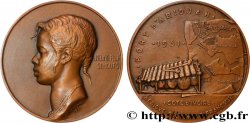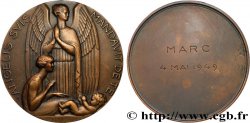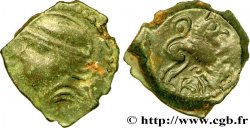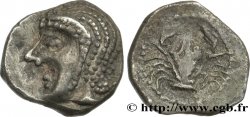You must signin and be an approved bidder to bid, LOGIN TO BID. Accounts are subject to approval and the approval process takes place within 48 hours. Do not wait until the day a sale closes to register. Clicking on « bid » constitutes acceptance of the terms of use of cgb.fr private e-auctions.
Bids must be placed in whole Euro amounts only. The sale will start closing at the time stated on the item description; any bids received at the site after the closing time will not be executed. Transmission times may vary and bids could be rejected if you wait until the last second. For further information ckeck the E-auctions F.A.Q.
NO BUYER'S FEE.
NO BUYER'S FEE.
| Estimate : | 200 € |
| Price : | 54 € |
| Maximum bid : | 60 € |
| End of the sale : | 18 November 2019 18:28:30 |
| bidders : | 8 bidders |
Type : Médaille de la Légion Étrangère
Date: 1951
Metal : bronze
Diameter : 68 mm
Orientation dies : 12 h.
Engraver M
Weight : 171 g.
Edge : inscrite : LA LEGION” A SON VICE-PRESIDENT HONORAIRE. KAUFFMANN 1901-1951 + corne BRONZE
Puncheon : corne BRONZE
Coments on the condition:
Intéressante médaille, très massive, en excellent état de conservation
Obverse
Obverse legend : LÉGION / ÉTRANGÈRE.
Obverse description : Deux légionnaires armés, regardant à gauche.
Reverse
Reverse legend : HONNEUR . FIDELITE . VALEUR . DISCIPLINE.
Reverse description : Flamme, symbole de la Légion.
Commentary
Tranche inscrite ; “LA LEGION” A SON VICE-PRESIDENT HONORAIRE. KAUFFMANN 1901-1951.”
La Légion étrangère est un corps de l'armée de terre française disposant d'un commandement particulier. La légion est également indépendante du point de vue de son recrutement.
Formée en 1831 pour permettre l'incorporation de soldats étrangers dans l'armée française, une partie de ses unités a fait partie, jusqu'en 1962, fin de la période coloniale, du 19e corps d'armée, noyau de l'Armée d'Afrique.
L'engagement à la Légion est réservé aux hommes dont l'âge est compris entre 17 ans et 40 ans (dérogation possible) et a compté depuis sa création et jusqu'en 1963 plus de 600 000 soldats dont une majorité d'Allemands, suivi de 3 fois et demie moins d'Italiens, puis de Belges, mais aussi de Français, d'Espagnols et de Suisses. De nombreuses autres nationalités sont représentées, comme les pays d'Europe de l'Est et les Balkans, majoritaires dans les années 2000. Ce corps d'armée reste, pour la majorité, un moyen d'immigration privilégié afin de changer de vie, d'oublier son passé, de se faire oublier, ou tout simplement de trouver une vie meilleure. Pour quelques autres, le prestige de la Légion et l'amour du pays demeurent la cause de leur volontariat. Les motifs de l'engagement ainsi que le recrutement restent encore aujourd'hui un sujet plus ou moins tabou, même si le sujet est souvent abordé au sein de la Légion lors du processus de recrutement..
Inscribed slice; “THE LEGION” HAS ITS HONORARY VICE-PRESIDENT. KAUFFMANN 1901-1951. \\\"The Foreign Legion is a corps of the French army with a specific command. The legion is also independent in terms of its recruitment..
Formed in 1831 to allow the incorporation of foreign soldiers into the French army, some of its units were part, until 1962, the end of the colonial period, of the 19th Army Corps, the core of the Army of Africa..
Enlistment in the Legion is reserved for men aged between 17 and 40 (exceptions possible) and since its creation until 1963 has numbered more than 600,000 soldiers, the majority of whom were German, followed by 3.5 times fewer Italians, then Belgians, but also French, Spanish and Swiss.. Many other nationalities are represented, such as Eastern European countries and the Balkans, which were the majority in the 2000s.. This army corps remains, for the majority, a preferred means of immigration in order to change their lives, to forget their past, to be forgotten, or quite simply to find a better life.. For some others, the prestige of the Legion and love of country remain the reason for their volunteering.. The reasons for enlistment and recruitment remain a more or less taboo subject even today, even if the subject is often addressed within the Legion during the recruitment process..
La Légion étrangère est un corps de l'armée de terre française disposant d'un commandement particulier. La légion est également indépendante du point de vue de son recrutement.
Formée en 1831 pour permettre l'incorporation de soldats étrangers dans l'armée française, une partie de ses unités a fait partie, jusqu'en 1962, fin de la période coloniale, du 19e corps d'armée, noyau de l'Armée d'Afrique.
L'engagement à la Légion est réservé aux hommes dont l'âge est compris entre 17 ans et 40 ans (dérogation possible) et a compté depuis sa création et jusqu'en 1963 plus de 600 000 soldats dont une majorité d'Allemands, suivi de 3 fois et demie moins d'Italiens, puis de Belges, mais aussi de Français, d'Espagnols et de Suisses. De nombreuses autres nationalités sont représentées, comme les pays d'Europe de l'Est et les Balkans, majoritaires dans les années 2000. Ce corps d'armée reste, pour la majorité, un moyen d'immigration privilégié afin de changer de vie, d'oublier son passé, de se faire oublier, ou tout simplement de trouver une vie meilleure. Pour quelques autres, le prestige de la Légion et l'amour du pays demeurent la cause de leur volontariat. Les motifs de l'engagement ainsi que le recrutement restent encore aujourd'hui un sujet plus ou moins tabou, même si le sujet est souvent abordé au sein de la Légion lors du processus de recrutement..
Inscribed slice; “THE LEGION” HAS ITS HONORARY VICE-PRESIDENT. KAUFFMANN 1901-1951. \\\"The Foreign Legion is a corps of the French army with a specific command. The legion is also independent in terms of its recruitment..
Formed in 1831 to allow the incorporation of foreign soldiers into the French army, some of its units were part, until 1962, the end of the colonial period, of the 19th Army Corps, the core of the Army of Africa..
Enlistment in the Legion is reserved for men aged between 17 and 40 (exceptions possible) and since its creation until 1963 has numbered more than 600,000 soldiers, the majority of whom were German, followed by 3.5 times fewer Italians, then Belgians, but also French, Spanish and Swiss.. Many other nationalities are represented, such as Eastern European countries and the Balkans, which were the majority in the 2000s.. This army corps remains, for the majority, a preferred means of immigration in order to change their lives, to forget their past, to be forgotten, or quite simply to find a better life.. For some others, the prestige of the Legion and love of country remain the reason for their volunteering.. The reasons for enlistment and recruitment remain a more or less taboo subject even today, even if the subject is often addressed within the Legion during the recruitment process..








 Report a mistake
Report a mistake Print the page
Print the page Share my selection
Share my selection Ask a question
Ask a question Consign / sell
Consign / sell
 Full data
Full data















